In: portraits
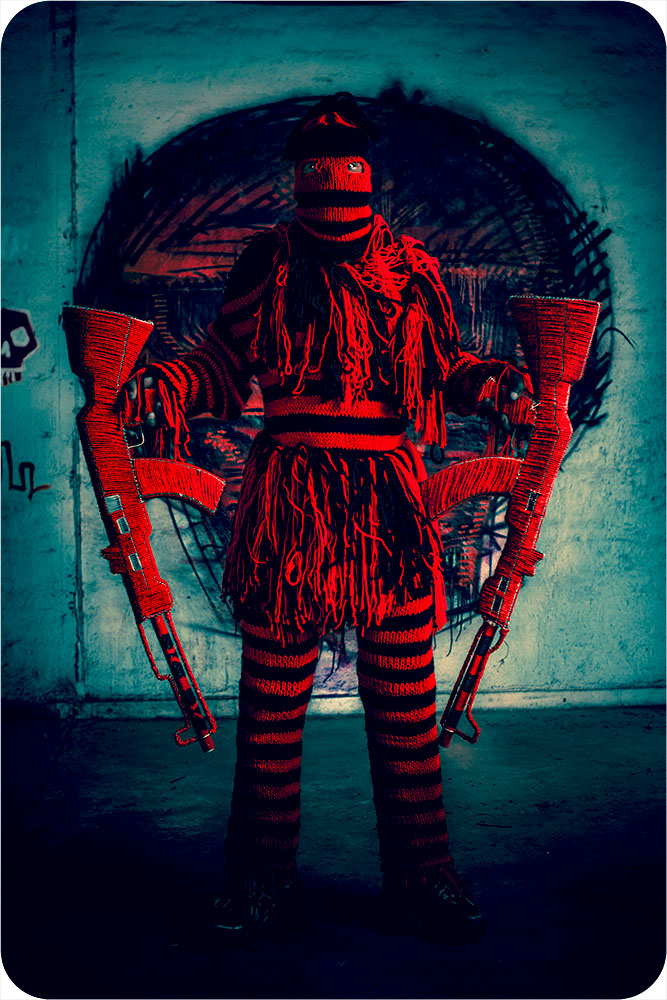
Ralph Ziman | The Ghosts Project
May 12, 2023Ralph Ziman | The Ghosts Project
The total life of man is reflected in his art. And so when people come to us and say, “Why are you… you artists so political?” I don’t know what they are talking about. Because art is political. And further more I’d say this, that those who tell you “Do not put too much politics in your art,” are not being honest. If you look very carefully you will see that they are the same people who are quite happy with the situation as it is. And what they are saying is not don’t introduce politics. What they are saying is don’t upset the system. They are just as political as any of us. It’s only that they are on the other side. Now in my enthusiasm, art cannot be on the side of the oppressor.
(Chinua Achebe in conversation with James Baldwin, 1981)
The ghosts won’t starve, but we will perish.
(Paul Virilio)
Since approximately 2014, South African filmmaker and artist Ralph Ziman’s The Ghosts Project has been enacted in a number of nation states in Africa. In Ziman’s words: “Arms that are paid for and imported into Africa are being used by individuals not just for defense but often by corrupt, autocratic governments to oppress their own people. This body of work deals with the international arms trade and Africa, a trade that for the most part only goes in one direction — into Africa — and one that not only fuels, but also sustains conflict across the continent.”
One aspect of the project involved Ziman photographing “Zimbabwean street vendors wielding handmade replicas of AK-47s which are adorned in traditional Shona-style beading. The multimedia project aims to highlight the international arms trade and its devastating influence.
Another iteration of this performative hybrid of fine craft and photography – and also an intervention into public spaces – is as follows: “I had six Zimbabwean artists use traditional African beads and wire to manufacture several hundred replica bead/guns like AK-47s, as well as several replica bead/general purpose machine guns (GPMGs), along with the ammunition. In response to the guns sent into that culture, the mural represents an aesthetic, anti-lethal cultural response, a visual export out of Africa. And the bead/guns themselves, manufactured in Africa, are currently being shipped to the USA and Europe. This bead/arms project provided six months full-time work for half a dozen craftsman who got well deserved break from making wire animals for tourists.
The completed bead/guns were the subject of a photo-shoot in crime ridden downtown Johannesburg. The subjects were the artists who made the guns, several construction workers who happened to witness the shoot, and a member of the South African Police Services who just wanted his picture taken.” (from here)
Ralph Ziman was born in Johannesburg, South Africa, and currently lives and works in Los Angeles, California : “His practice is motivated by a sense of social responsibility toward global politics. Using imagery that is at once vivid and dark, he comments on serious issues such as life under apartheid, the arms trade and trophy hunting. His work extends across a variety of media, including film, photography, public intervention, sculpture, and installation.”
More of Ralph Ziman’s work can be seen here.
~ Bart Gazzola
Read More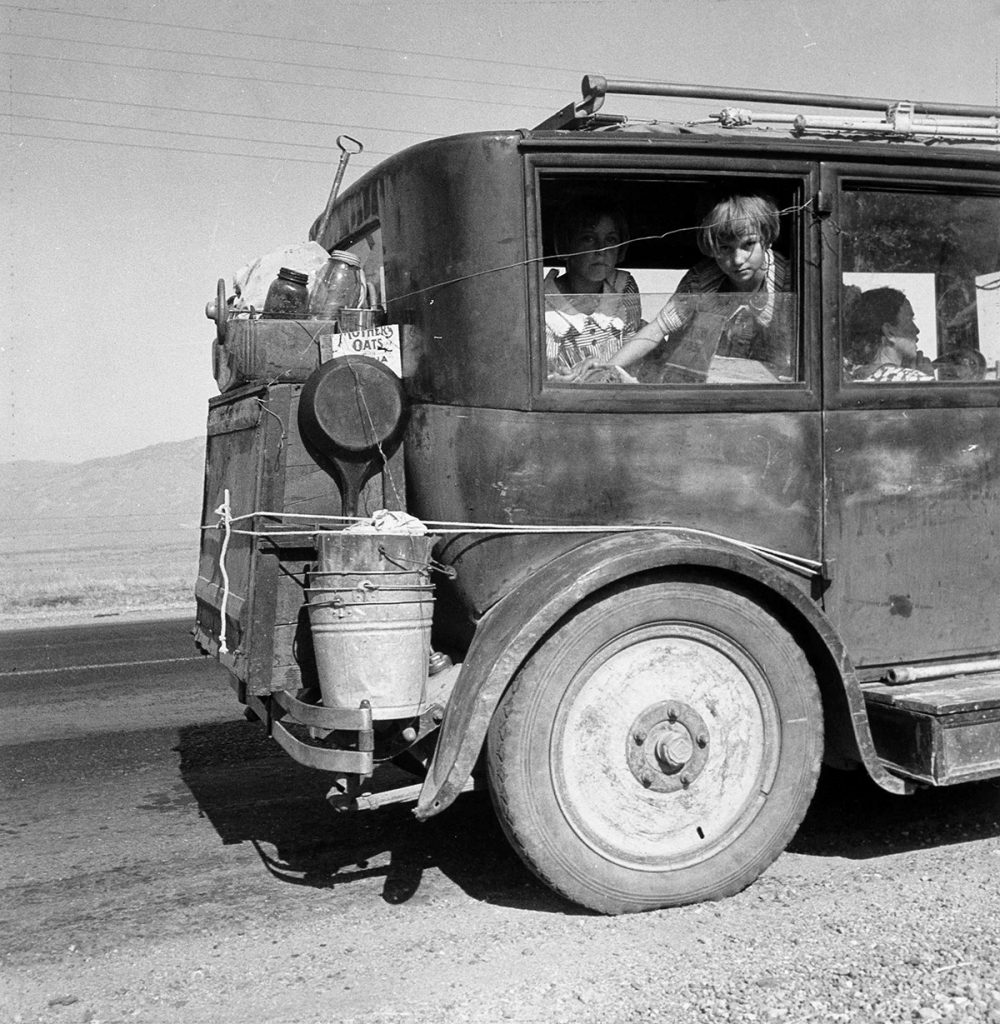
Dorothea Lange | A family of drought refugees from Abilene, Texas, on the road in California | 1936
May 4, 2023Dorothea Lange (1895 – 1965) | A family of drought refugees from Abilene, Texas, on the road in California | 1936
“The depression was making people disappear.
They vanished from factories and warehouses and workshops, the number of toilers halving, then halving again, until finally all were gone, the doors closed and padlocked, the buildings like tombs. They vanished from the lunchtime spots where they used to congregate, the diners and deli counters where they would grab coffee on the way in or a slice of pie on the way out.
They disappeared from the streets.
They were whisked from the apartments whose rents they couldn’t meet and carted out of the homes whose mortgages they couldn’t keep pace with, lending once thriving neighborhoods a desolate air, broken windows on porches and trash strewn across overgrown yards. They disappeared from the buses and streetcars, choosing to wear out their shoe leather rather than drop another dime down the driver’s metal bucket. They disappeared from shops and markets, because if you yourself could spend a few hours to build it, sew it, repair it, reline it, reshod it, reclod it, or reinvent it for some other purpose, you sure as hell weren’t going to buy a new one.
They disappeared from bedrooms, seeking solace where they could: a speakeasy, or, once the mistake of Prohibition had been corrected, a reopened tavern, or another woman’s arms—someone who might not have known their name and certainly didn’t know their faults well enough to judge them, someone who needed a laugh as badly as they did.
They disappeared, but never before your eyes; they never had that magic. It was like a shadow when the sun has set; you don’t notice the shadow’s absence because you expect it. But the next morning the sun rises, and the shadow’s still gone.”
(Thomas Mullen, The Many Deaths of the Firefly Brothers)
I have a tendency in my research to fall down rabbit holes: this is often shaped by history (my interest – which has manifested on this site – in post Soviet artists, for example) and of late The Great Depression has been a point of interest. My enjoyment of horror intersects here, so I will confess that I came to the author that I quote liberally above (whose book follows two brothers whom are bank robbers during the Great Depression, harshly factual and researched, but they find they are resurrected each time they’re killed in one of their robberies) through Daniel Knauf’s Carnivàle series. But, like another writer has pointed out, improbability and violence overflow from ordinary life, and the Great Depression was a time more, perhaps, malleable than most, as many assumptions were fractured irreparably…
And the horrors experienced by many from the Crash of 1929 through the Depression were ‘unimaginable’ to many, until they became commonplace, and now, it seems, have been forgotten. This is similar to how we forget that Lange’s subjects are not just icons but actual people who lived, suffered and died.
To many, Lange’s work requires no introduction. Many of her photographs are so stitched into the fabric of a communal history that they act as signifiers for collective memories. Nonetheless: Dorothea Lange “was an American documentary photographer and photojournalist, best known for her Depression-era work for the Farm Security Administration (FSA). Lange’s photographs influenced the development of documentary photography and humanized the consequences of the Great Depression.” (from here)
I return to Mullen’s book that had flavours of horror, but not in the way I expected, as it was more historical than ‘supernatural’ horror:
“Ten feet behind them, standing at the base of an arc light and looking in the opposite direction, was a young, balding man who Weston supposed was the father. The man looked as if he were trying very hard to become invisible.
When you bump into an old acquaintance on the street, you ask him how he’s doing. He tells you a story and then you tell him your story, and both of you are trying to see where you fit within the other’s. Your story says: This is the way the world is, and I’m the center, over here. But if the other guy tells a different story, with the world like this, where the center’s actually over here, then you realize that you’re way off to the side.
This man did not need to be told he was off to the side. He clearly realized it.”
More of Lange’s work – both her iconic images of The Great Depression and her later work that was more local but considered the same issues of justice and equality – can be seen here.
~ Bart Gazzola
Read More
Kristina Varaksina | Self portrait wrapped, 2020
April 27, 2023Kristina Varaksina | Self portrait wrapped, from the Self Reflection series, 2020
“Why do men feel threatened by women?” I asked a male friend of mine. (I love that wonderful rhetorical device, “a male friend of mine.” It’s often used by female journalists when they want to say something particularly bitchy but don’t want to be held responsible for it themselves. It also lets people know that you do have male friends, that you aren’t one of those fire-breathing mythical monsters, The Radical Feminists, who walk around with little pairs of scissors and kick men in the shins if they open doors for you. “A male friend of mine” also gives — let us admit it — a certain weight to the opinions expressed.)
So this male friend of mine, who does by the way exist, conveniently entered into the following dialogue. “I mean,” I said, “men are bigger, most of the time, they can run faster, strangle better, and they have on the average a lot more money and power.” “They’re afraid women will laugh at them,” he said. “Undercut their world view.”
Then I asked some women students in a quickie poetry seminar I was giving, “Why do women feel threatened by men?” “They’re afraid of being killed,” they said.
(Margaret Atwood, Second Words: Selected Critical Prose, 1982)
Kristina Varaksina received her Master’s in Photography from the Academy of Art University, San Francisco, in 2013. Born in Russia, Varaksina has resided in the USA since 2010 and currently divides her time between London and New York.
From here: “In her personal work, Varaksina explores the vulnerabilities, insecurities and self-search of a woman and an artist. Her work is a creative response to what’s going on in the world and her immediate environment. Through visual symbolism, carefully curated colour palettes and cinematic lighting she reflects the strongest emotions she and her subjects experience.” I would inject another line from Atwood here, in response: I’m working on my own life story. I don’t mean I’m putting it together; no, I’m taking it apart.
Varaksina gives voice to women from different ethnic, socio-economic, and cultural backgrounds, each doing their best to accept themselves as who they are and be proud of that. Varaksina sees her job as a photographer to make “ordinary” women more visible and therefore, more valuable.”
Varaksina has earned numerous awards for her work: her figures alternate between an unflinching gaze that challenges – perhaps unnerves – the viewer, and a stillness where our presence is neither requested or needed, intruding into the quiet being of her subjects. The Self Reflection series – which is ongoing – has been described as both ‘claustrophobic’ and a commentary on the history of portraiture in the Western canon. In this body of work, her stare is direct and unrelenting, as she not only turns her camera on herself as part of her work about women but turns her gaze upon us, too.
More of her work can be seen here. Varaksina’s IG is @kristinavaraksina
~ Bart Gazzola
Read More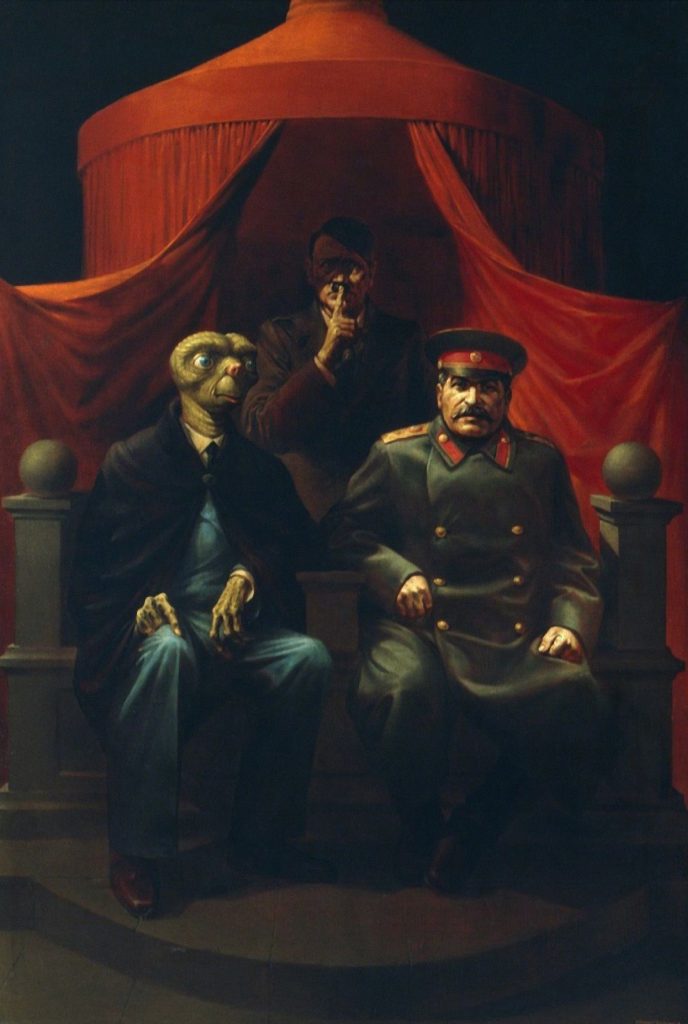
Komar and Melamid | Yalta Conference, 1982
January 26, 2023Komar and Melamid, Yalta Conference, from the “Nostalgic Socialist Realism” series, 1982
I enjoy speculative fiction and recently was reading Harry Turtledove’s Joe Steele. It’s a stand alone story, but you may be familiar with his Southern Victory series (in which the Confederate States survive the American Civil War, and it stretches into the mid twentieth century, offering alternate – yet familiar – takes on everything from WW I to the Holocaust) or World War / Colonization books. That series of books inject an alien invasion into the midst of WW II. This might sound ludicrous, until you read them and one of the aliens observes that – upon their discovery of Buchenwald and Auschwitz – that clearly humans are monstrously incapable of governing ‘ourselves.’ It’s an interesting tonic to the proliferation of science fiction that posits an alien deus ex machina that proffers the narrative that humans are special – such as Arthur C. Clarke’s Childhood’s End, for example. Perhaps it’s because Clarke was more hopeful, and much has happened since then…
“The novel [Joe Steele] explores what might have happened had Joseph Stalin been raised in the United States, postulating his parents having emigrated a few months before his birth, instead of remaining in the Russian Empire. It depicts Stalin (in this history, taking the name Joe Steele) growing up to be an American politician, rising to the presidency and retaining it by ruthless methods through the Great Depression, World War II, and the early Cold War. The president is depicted as having the soul of a tyrant, with Stalin’s real-world career mirrored by actions taken by Steele.” (from here)
But I mention Turtledove’s Joe Steele as it reminded me of Komar and Melamid’s painting Yalta Conference, from the Nostalgic Socialist Realism series, 1982. This work has also been the cover image for Boris Groys’ seminal book The Total Art of Stalinism: Avant-Garde, Aesthetic Dictatorship, and Beyond (2011). The ‘inspiration’ for this painting is a famous photograph.
Komar & Melamid are interesting for their cultivated personas as much as their art. This painting can’t help but offer and foment a myriad of interpretations, drawing upon not just the ‘players’ but the moment it re imagines. Yalta was, after all, the point at which the shaky alliance between the USSR and the United States began to seriously fracture. The employment – or appropriation – of ‘socialist realism’ (a style that was the official style of the USSR but that – to quote a Soviet born historian – was like Pravda, in that you can find some grain of truth by what it ignores) only makes this a ‘scene’ even more about failure (like the Yalta Conference was, towards any peace in a Post WW II world) than progress, with a sprinkling of absurdity and skepticism, with the hushing Hitler and American leader a goggle eyed alien….
Boris Groys, in writing about Komar and Melamid, offered the following about their aesthetic: “[The artists] themselves, however, perceive no sacrilege whatever here, because they consider the religion of the avant-garde to be false and idolatrous.”
More from Groys, that could also apply to this painting, and the multiplicities of potential interpretations of it (combined with the irreverence of Komar and Melamid’s larger practice): “[in] the West, the march of progress is “aimless” – one fashion succeeds another, one technical innovation replaces another and so on. The consciousness that desires a goal, meaning, harmony, or that simply refuses to serve the indifferent Moloch of time is inspired to rebel against this progress. Yet the movement of time has resisted all rebellions and attempts to confer meaning upon, control, or transcend it.”
More of Komar & Melamid’s work – and their unique aesthetic and legacy – can be enjoyed here. If you’re interested, more about Boris Groys’ writings and ideas can be read here.
~ Bart Gazzola
Read More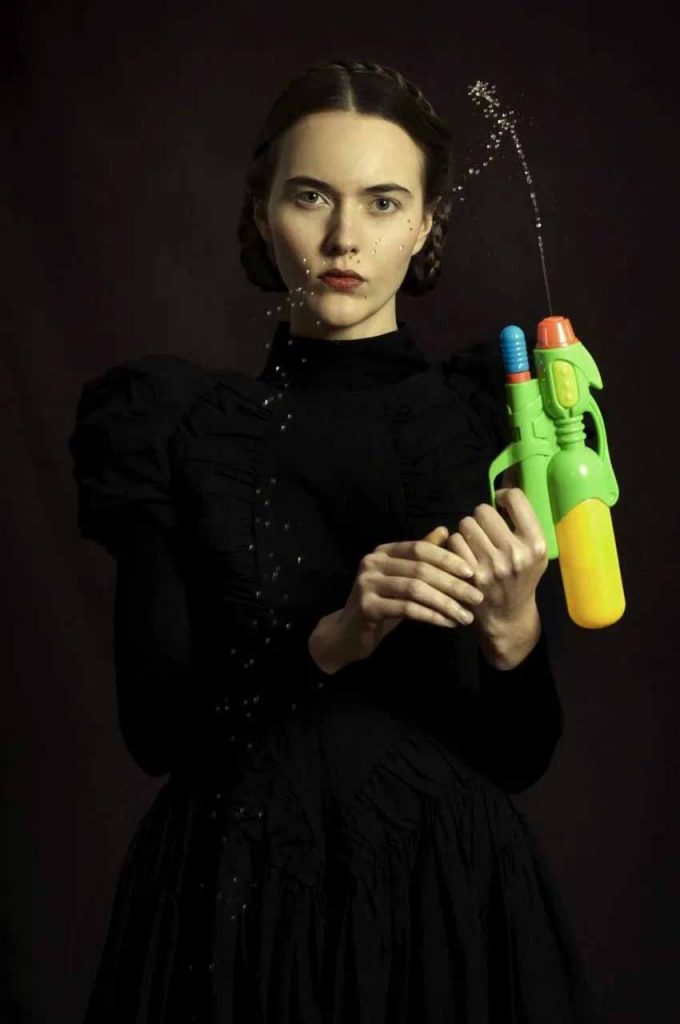
Romina Ressia | Woman with a Water Pistol, 2014
January 6, 2023Romina Ressia | Woman with a Water Pistol, 2014
Most of the writing around Ressia’s photographs talks about absurdity and anachronism: perhaps that’s because she appropriates form and redefines meaning in a manner that challenges art historical tropes around gender and relevance. Meticulously executed, her ‘portraits’ have a gravitas on the one hand, but then this is broken by elements that can’t help but amuse (though her people never crack a smile, with eye contact that might wilt any irreverence from the viewer).
There is a hint of dourness to the woman who is the player in this series, and many others, having a heavy handed seriousness that is then fractured by the various objects her subjects are brandishing that seem silly and puerile.
Bluntly, Messia’s Woman with a Water Pistol looks like she’s had just about enough of you, young man, and unless you want to be sprayed with water – disciplined like an unruly, disobedient cat – you’d best behave. You shan’t be told again.
A bit flippant perhaps. But consider the [still, uninterrupted] proliferated misogyny in Western art history [or contemporary art] of women as object, or demure commodity, or the validation / apologia of rape as seen with Europa or the Sabine women or ‘Susannah and the Elders’ (and so, so many others). Consider that in (recently done) 2022 we’ve seen groups of women around the world make it clear that they have had *quite* enough and my interpretation is not without consideration….
This image is part of a larger series titled How would have been Childhood? with the same figure in them all, her unimpressed body language acting as a unifying aspect of the artworks. Birthday hats, costumes, balloons – nothing seems to inspire joy, here. When I first encountered this series online, a birthday party that no one was enjoying – if anyone even came, besides the ‘star’ of the series – can be forgiven for being an initial impression….
“Romina’s art cleverly initiates dialogue on important contemporary social issues through the striking use of anachronistic tropes juxtaposed with mundane and banal elements of modernity. Indeed, the influence of classical artists like Da Vinci, Rembrandt and Velazquez is instantly recognizable in the palettes, textures, ambiance and scenes captured in Romina Ressia’s works, bequeathing them an air of familiarity which only serves to highlight the contradictory and sometimes confrontational presence of objects of modernity such as cotton candy, bubble gum, microwave popcorn and Coca Cola.
The theatrical absurdity in her pictorial compositions, which combine stylistic elements of Renaissance paintings and Pop art, and the dissonance of the stark contradictions captured therein have a surprising clarity, making for an honest critique through visual dialogue of received notions of modernity. In this sense, Romina succeeds in achieving her artistic intent which is not to recreate or refer to the past but to establish a frame within which to interrogate the perceived evolution and progress of society especially in respect to the role and identity of women.” (from here)
If you’re doltish enough to suggest ‘she’d look better if she smiled’, don’t be surprised if you get soaked – deservingly.
More of Romina Ressia’s evocative – if a bit disquieting – work can be seen here.
Her Instagram is @rominaressia
~ Bart Gazzola
Read More
Elena Chernyshova | Days of Night / Nights of Day, 2012-2013
December 8, 2022Elena Chernyshova | Days of Night / Nights of Day, 2012-2013
‘I was with my people then, there, where my people, unfortunately, were.’
(Anna Akhmatova, Requiem, 1935 – 1961, writing of her times in the soviet gulag)
When I lived in Saskatoon, an acquaintance who’d spent time in Eastern Europe once commented that that city in winter was like Siberia, but without the cachet of being that place (which exists as much in our imaginations as it does in reality, one might say – as a ‘great part of the imagination of the world is attached to that site’), nor with architecture that was anything but a failed brutalism (this was during a period with the ‘economic boom’ in Saskatoon where a number of heritage buildings were lost and the banal taupe of others rose like mottled angular tumours….)
Elena Chernyshova’s work is aesthetically stunning: not just for the evocative quality of the images, but also for the scenes they present to us, that seem to blend exotica and danger, a chronicle of sites that remind us of the irrelevance of humanity in the face of nature.
But her notes and comments bring the human element back, as this is not just a ‘pretty’ image, but a site of – of course – contested narratives, that looks back to the history of the USSR and some of the ideas of industrialization and ‘progress’ that have human costs.
Chernyshova’s own words are a powerful adjunct to her lens: “Days of Night / Nights of Day is about the daily life of the inhabitants of Norilsk. Norilsk is a mining city, with a population of more than 170,000. It is the northernmost city (100,000+ people) in the world. The average temperature is -10° C and reaches lows of -55° C in the winter. For two months of the year, the city is plunged into polar night when there are zero hours of sunlight.
The entire city, its mines and its metallurgical factories were constructed by prisoners of the nearby gulag, Norillag, in the 1920s and 30s. 60% of the present population is involved with the city’s industrial processes: mining, smelting, metallurgy and so on. The city sits on the world’s largest deposit of nickel-copper-palladium. Nearly half of the world’s palladium is mined in Norilsk. Accordingly, Norilsk is the 7th most polluted city in the world.
This documentary project aims to investigate human adaptation to extreme climate, environmental disaster and isolation. The living conditions of the people of Norilsk are unique, making them an incomparable subject for such a study.”
Chernyshova offers the following about the image of monumental architecture (with a blue suffusing light): The construction plan of Norilsk was established in 1940, by architects imprisoned in the nearby Gulag. The idea was to create an ideal city. The most “ancient” buildings are constructed in the Stalinist style. The next step of construction happened in the 60s, when the prevailing method in the USSR was to use pre-built panels.
Her other writings also allude to the disputed, if not adversarial, stories that meet and intersect in Days of Night / Nights of Day. The scene with the car and hazy clouds the colour of sulfur has the following notation: In the summer, there is a period when the sun doesn’t go under the horizon. This continues from the end of May till the end of July. It is accompanied by good weather and pleasant temperatures. Around 3 am, while the city sleeps, it is still illuminated by the sun. The city seems like a ghost town, emptied of its inhabitants.
One of the images I’ve included from Chernyshova’s series is unlike the others: and its difference helps to offer insight into the whole. Again, Chernyshova’s voice must be borrowed: Anna Vasilievna Bigus, 88, [who] spent ten years of her youth in the Gulag. At age 19, she was separated from her family and sent into the Arctic Circle. “The only joy we could have in Gulag was singing. We sang a lot. And this gave us the strength to survive…” Her daughter became a music teacher and her grandchildren sing in opera.
The complete series (produced with the support of The Jean-Luc Lagardère Foundation) can be seen here and a feature from LensCulture (where Chernyshova offers some words about many of the images I’ve shared here, that offer more nuance and depth to her vision) can be enjoyed here.
Elena Chernyshova’s site
@elena.chernyshova.photography
~ Bart Gazzola
Read More
Haruko Maeda | Self – Portrait with my cat and my grandmother in a glass, 2020
December 2, 2022Haruko Maeda | Self – Portrait with my cat and my grandmother in a glass, 2020
Several years ago, when I was going through the library of a recently deceased friend – at the invitation of his daughter – I noticed in his (former) apartment that she had a velvety bag, looking lustrous and fancy. I asked if this was some expensive alcohol, to mark her father’s passing. She told me it was her father’s ashes. When I asked if they’d be scattered in the city we were in, as he’d lived there for some time, contributing to the critical writing community and being a significant voice around visual culture and especially photography, or back in his home province in the Maritimes, she tersely commented she had not decided yet whether they’d be flushed down the toilet or mixed in with the cat litter.
When my own father passed several years ago, not long before COVID, the arrangements around his inurnment were put on hold: his ashes sat on a shelf in the living room of what is now my mother’s house for some time, only recently being put underground this past summer. Frankly, having ‘him’ in the same room where he spent most of the final years of his life seemed to comfort my mother: he was more agreeable than he’d been in decades, ahem.
No, I am not smiling – my face is as stoic and unreadable as Maeda’s, in her painting.
Those are both dark places to begin in considering Haruko Maeda’s painting Self – Portrait with my cat and my grandmother in a glass: but the funerary rites and rituals of family are nothing if not contested narratives that bring feelings to the surface, re opening old wounds and making new ones. Leave the dead to bury the dead, they (Matthew and Luke, to be specific, but that may just be hyperbole) say, but they never truly ‘leave’ us….
Maeda looks unperturbed in this scene: her cat seems relaxed, and even the fly that perches upon her arm that holds the ashes of her grandmother is subtle.
“Japanese Haruko Maeda lives and works in Austria since 2005. In her art she combines the Shintoistic traditions of her homeland with the Roman Catholic faith, deeply rooted in Austrian culture and history. This allows her to position herself between East and West. Maeda lets these double belongings function as a kind of filter through which she can process her own memories and experiences. The purpose is to raise universal questions about existence, life and death.” (from here)
In Neil Gaiman’s Sandman series, the final story arc – The Wake – offers several vignettes as concluding narratives about death, loss and mourning. One of these involves a man cast into exile, after the death of his son, who gets lost in a desert that his guides will not name, as to do so is to invite disaster. Master Li finds a tiny kitten as a companion, a ward, perhaps, against the ghosts of the dead he encounters in the ashy, shifting sands. At some point he encounters the shade of his son, and this is their conversation:
“Father? I am your son. That is only a kitten. Why do you abandon me to chase after it?”
“When you were alive, you were all my joy. Now you are dead. I see you only in my dreams. And when I awake my pillow is wet with tears. The kitten is living, and it needs my help.”
There is a solemnity to Maeda’s work, but also just a touch of irreverence.
More of Haruko Maeda’s work can be seen here.
~ Bart Gazzola
Read More
Stéphane Alexis’ Chains & Crowns
January 23, 2022Stéphane Alexis’ Chains & Crowns Rita Godlevskis Stéphane Alexis from the Chains & Crowns series, 2020 It is clear, even at... Read More
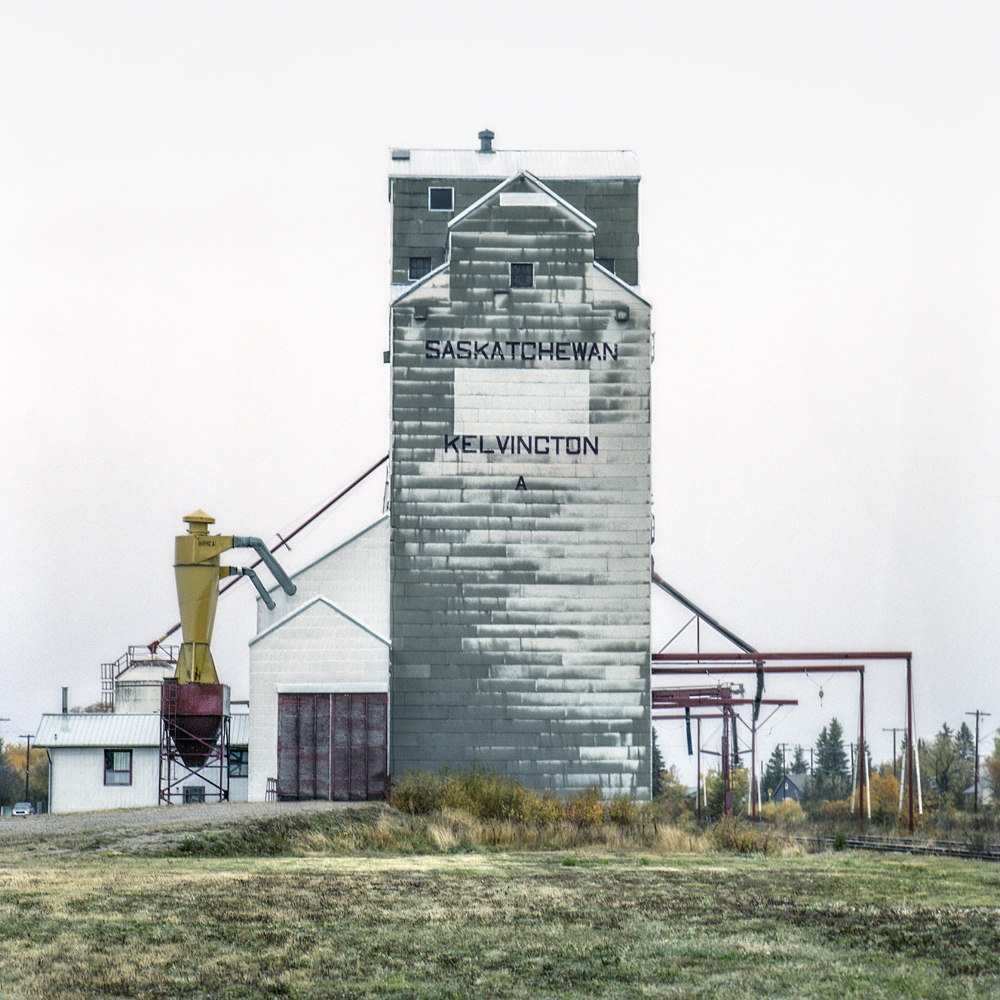
Discovering Self: The Photography of Vera Saltzman
January 4, 2022Discovering Self The Photography of Vera Saltzman Grain Elevator No. 18 This article originally featured in the TYPOLOGIES edition of photoED... Read More
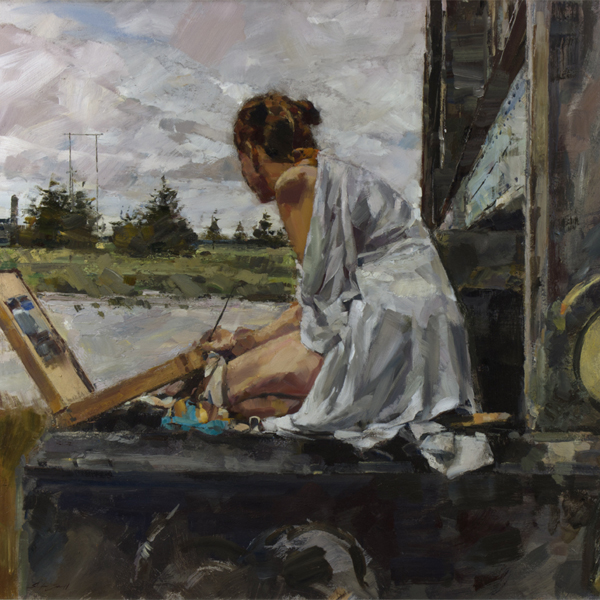
Sophie’s Choice – A Muse for Stephen
October 13, 2021A muse, according to the Canadian Oxford Dictionary, is a poet’s inspiring goddess or the source of inspiration for creativity. Fredericton painter Stephen Scott is not a poet, but he has found his muse and certainly an inspiration for creativity in his wife Sophie Thériault Scott. Stephen has known Sophie since 2000 and they have been married since 2010. She has been the subject of many of his paintings since that first meeting, but being his muse is far more than being a model for him to paint. Her presence in his life has affected all of his art. After all, that is what a muse is supposed to do.
Virgil Hammock offers some thoughts on the art of Stephen Scott in this article.
Read More
Recent Comments